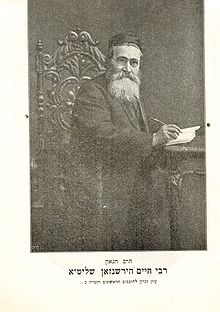- Chaim Hirschensohn
-
Rabbi Chaim Hirschensohn (1857 – 1935) was born in Tzfat, (city in the Galilee, Israel), to Rabbi Yaakov Mordechai Hirschensohn, who had emigrated there from Pinsk in 1848. In 1864, the family (which included Chaim's older brother, Rabbi Yitzchok Hirschensohn) moved to Jerusalem.
Like his brother, the young Zionist Chaim Hirschensohn worked with Eliezer Ben-Yehuda to revive spoken Hebrew and helped found the Safah Berurah ("Plain Language") society in Jerusalem. He and his wife Chava published works and journals both in Hebrew and Yiddish.
In 1904, he was hired as the Chief Rabbi of Hoboken, New Jersey, a post that included "Hoboken, West Hoboken, Jersey City Heights, Union Hill and the Environs" (from title page of Malki Ba-Kodesh, vol. 2; Hoboken, 1921[1]) in its jurisdiction. He remained in Hoboken until his death in 1935. Rabbi Hirschensohn wrote on many subjects, including the relationship between Judaism and democracy, the status of women, and conflicts between traditional Judaism and modern scholarship and science. He is probably best known for Malki Ba-Kodesh, a 6-volume work he published between 1919 and 1928, in which he explores the halakhot (Jewish laws) that might govern a future Jewish state.
Hirschensohn's daughter Tamar married Rabbi David de Sola Pool and another daughter, Tehilla Lichtenstein headed the Jewish Science movement.
Notes
Further reading
- Zohar, David. Jewish Commitment in a Modern World: R. Hayyim Hirschensohn and his Attitude Towards Modernity (Hebrew). Jerusalem: Shalom Hartman Institute, 2003.
- Zohar, David. Rabbi Hayyim Hirschensohn - The Forgotten Sage Who Was Rediscovered
- Marc Shapiro article
- Encyclopedia Judaica "Hirschensohn (Family)"
Categories:- Religious Zionist Orthodox rabbis
- Rabbis in Ottoman and British Palestine
- People from Safed
- 1857 births
- 1935 deaths
Wikimedia Foundation. 2010.

